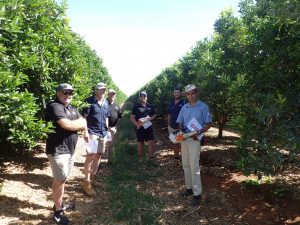15 April 2021
Afourer trial aims to improve long-term yields
14 April 2021
Key points
- Pruning strategies explored
- Trials on grower properties
- Mechanical hedging reviewed
A new project to develop best practice canopy management techniques in Afourers aims to improve long-term yields and minimise alternate bearing.
Afourer mandarins are recognised for producing high yields (60-90 tons per hectare) during the early years of production, sometimes peaking over 100 tons per hectare.
However as the trees grow large the yield begins to decline and alternate bearing becomes more prominent. Some growers of mature trees have reported average yields of 35 to 40 tons per hectare.
Excessive vigour and unmanaged watershoot growth are thought to contribute to yield decline in Afourer trees by shading the lower canopy.
Alternate bearing contributes to yield decline because the low crop load in ‘off’ years reduces long-term average yields.
In the short-term alternate bearing produces low-value small fruit in high crop load years, and in low crop load years leads to oversized fruit.
The project will investigate pruning strategies through replicated trials and demonstrations to minimise vigour and water shoots with the aim of improving long term yields and reducing alternate bearing.
Most of the trials are on grower properties in Sunraysia and the Riverina.

Steven Falivene and growers in the trial.
Project lead, Steven Falivene, NSW DPI, said the project has two objectives.
“Firstly, to develop best practice canopy management techniques to improve long-term yields and minimise alternate bearing in Afourer mandarins.
“Secondly, to develop capacity of Afourer growers in Australia by collating information locally and overseas, case studying growers, implementing on-farm trials and linking growers.”
Growers from all states are participating in the project with Andrew Creek (NSW DPI) managing the Riverina and Rachelle Johnstone (WA DPIRD) managing Western Australia.
“Already zoom meetings with South African researchers have been conducted and case study and background information report has been presented to the group,” Mr Falivene said.
Case studies will be conducted on most grower properties to explore the numerous management options currently being trialled by growers including hand thinning, chunk pruning, limb bending, annual limb removal, autumn water shoot removal and mechanical hedging.
The trial treatments will investigate multiple regrowth management events aligned with best management practices currently used by some Australian Afourer growers and recommended by South African researchers.
The management of the canopy and water shoots is not limited to hand pruning and includes mechanical hedging treatments.
“It is thought that developing a good limb structure and managing regrowth in autumn are important practices.
“The case study and background information report also concluded that that water shoots dominating the canopy is a common theme amongst growers that have problems with productivity.”

Membership
You are not logged in
If you are not already a member, please show your support and join Citrus Australia today. Collectively we can make big things happen.
